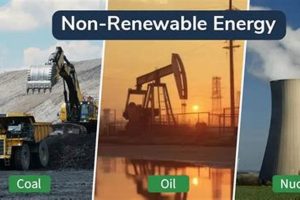
Uranium, a naturally occurring radioactive element, serves as the primary fuel in nuclear power plants. Its atoms undergo a process called nuclear fission, where they are split, releasing substantial amounts of energy... Read more »

Visual representations depicting power generation from naturally replenishing resources play a crucial role in education and advocacy. These depictions illustrate methods of harnessing energy from sources that are sustainable and have minimal... Read more »

Solar power harnesses electromagnetic radiation from the sun and converts it into usable electricity. This process relies primarily on photovoltaic (PV) technology, where semiconductor materials absorb photons, causing electrons to be released... Read more »

Energy resources that cannot be replenished at the rate they are consumed are classified as non-renewable. These resources are finite and their depletion raises significant environmental and economic concerns. A prime example... Read more »

The most economically viable method of generating power from naturally replenishing resources represents a pivotal aspect of sustainable energy strategies. This approach focuses on harnessing sources like solar, wind, geothermal, or hydro... Read more »

A component or system capable of providing electrical energy is fundamentally important for powering devices and infrastructure. These entities convert various forms of energy, such as chemical, mechanical, or radiant energy, into... Read more »

The categorization of energy sources as either renewable or non-renewable hinges on the rate at which they are replenished. Renewable resources are naturally replenished on a human timescale, such as solar, wind,... Read more »

These are naturally replenishing resources, capable of being renewed within a human lifespan. Common examples include solar radiation, wind power, geothermal heat, and hydropower derived from flowing water. Biomass, sourced from organic... Read more »

Certain energy resources are finite and deplete over time with use. These resources, formed from geological processes over millions of years, include fossil fuels like coal, petroleum, and natural gas, as well... Read more »

The question of whether hydrogen as an energy carrier qualifies as originating from sustainable sources is multifaceted. Hydrogen itself is an element found abundantly in water and organic compounds. However, it is... Read more »


